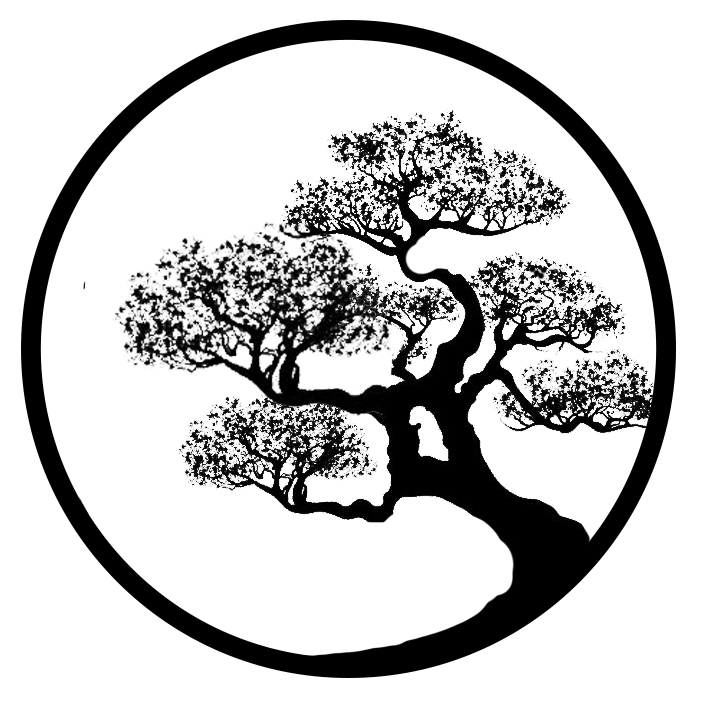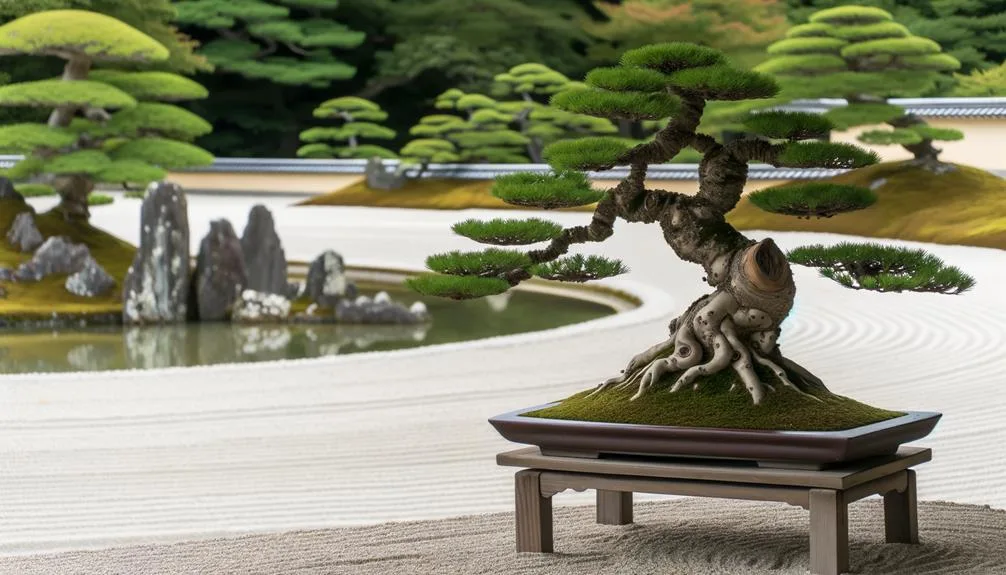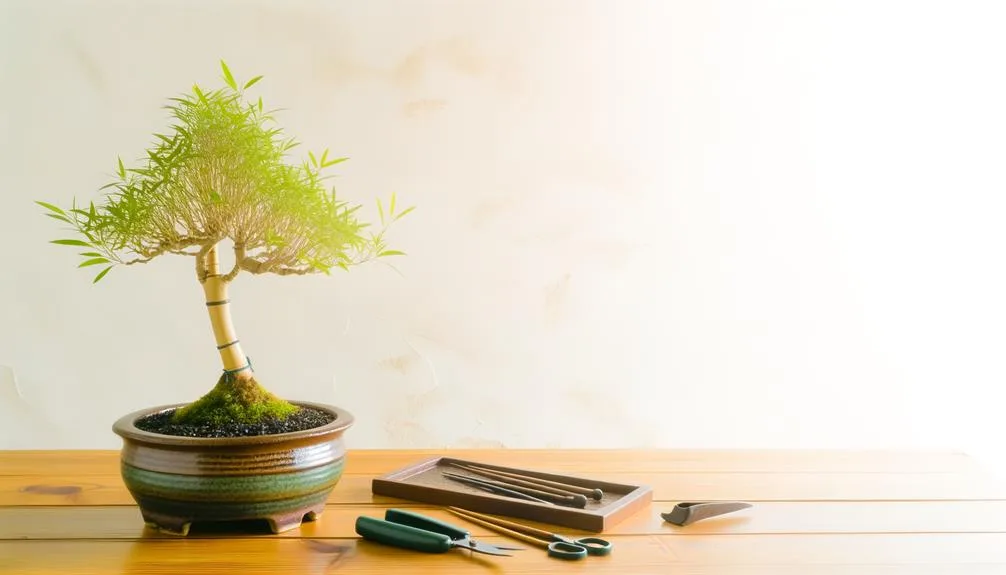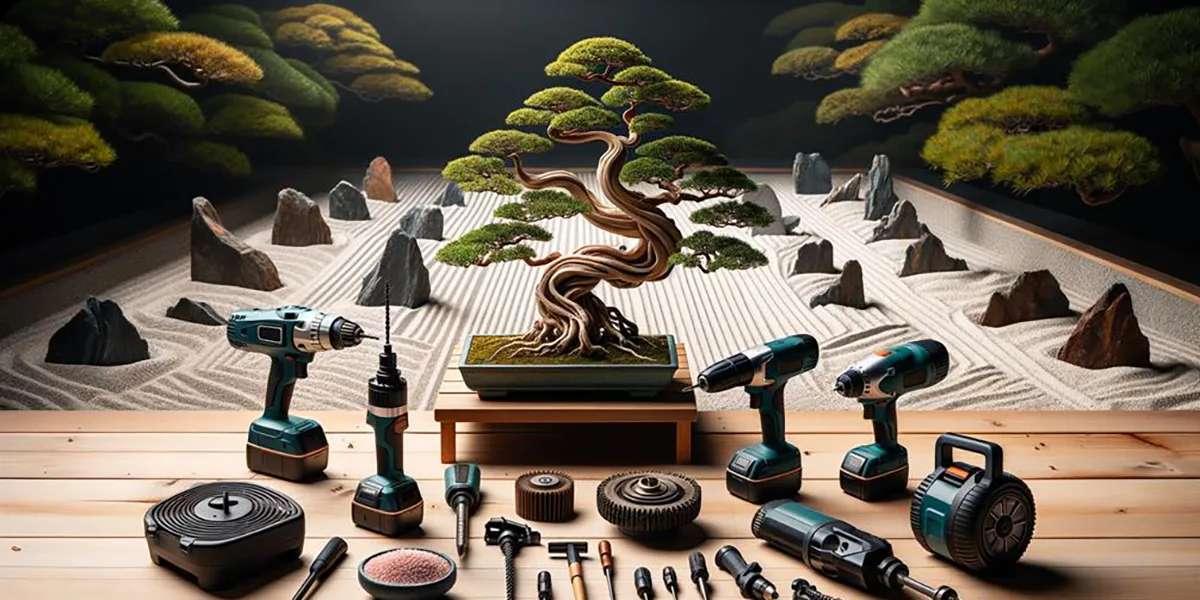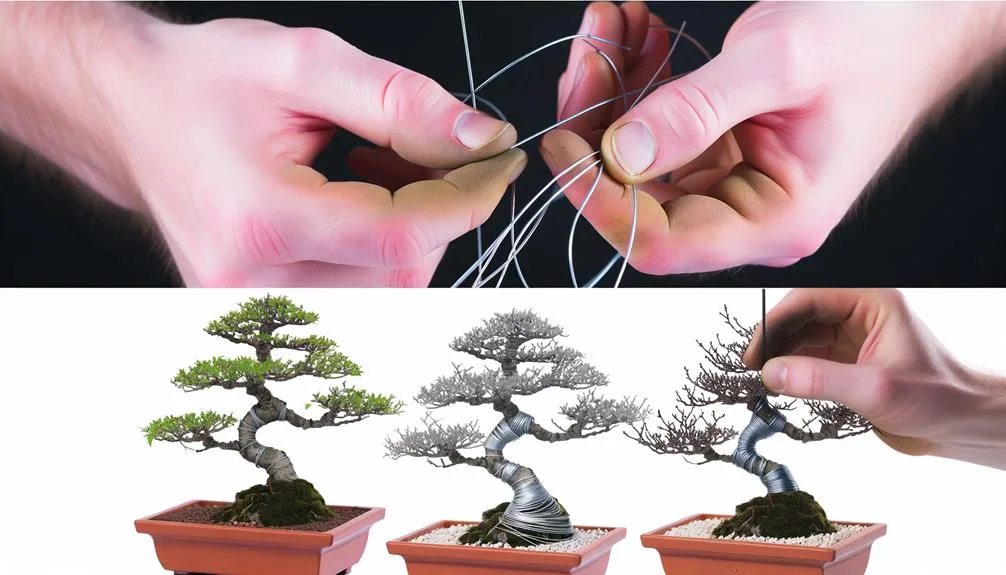Just as I’ve stumbled upon a serene forest during a hike, I’ve learned that it’s possible to bring that same tranquility into my own home through the art of bonsai.
Specifically, multi-trunk bonsai styles like Ikadabuki offer a unique means to encapsulate the essence of nature’s beauty. In this style, several trunks spring from the same root system, resembling a miniaturized forest or grove. Each trunk is carefully shaped by my hand for balance and aesthetic appeal.
Yet, there’s more to this art form, as I’ve discovered that other styles like Sokan and Sambon-yose provide further opportunities to craft intricate designs.
Now, wouldn’t you like to know how I go about it?
Key Takeaways
- Multi-trunk bonsai styles provide a platform for artistic expression and innovation.
- Ikadabuki technique resembles a raft and represents resilience and adaptation.
- Raft style involves using a fallen tree or manipulating a tree to resemble a fallen tree.
- Yose-ue style represents a forest with multiple trees and emphasizes the natural growth patterns of a forest.
Multi-Trunk Bonsai Styles
With multi-trunk bonsai styles like Ikadabuki, you’ll notice multiple trunks emerging from a single root base. Each trunk uniquely contributes to the overall balanced composition. Understanding these multi-trunk bonsai styles is critical to mastering this art form; it’s more than just growing a tree in a pot.
In a multi-trunk style bonsai, each trunk must exhibit a distinct character and contribute to the overall aesthetic equilibrium. This isn’t merely a style with a pair of trunks or even an odd count of trunks, each trunk in a bonsai presents a unique challenge in forming a visually pleasing composition.
A two-trunk style or a style with several trunks seeks to emulate the organic growth patterns of trees. It exhibits diversity and intricacy within the bonsai composition. The primary trunk of the bonsai tree, along with the other trunks, require thoughtful consideration in terms of positioning and balance.
Multi-trunk bonsai styles, incorporating styles like Ikadabuki and Kabudachi, provide a distinctive platform for artistic expression and innovation in bonsai design. With diligent practice and comprehension, one can master these fascinating bonsai styles.
Ikadabuki: The Raft Bonsai Style
Now let’s talk about the Ikadabuki technique, a unique bonsai style that resembles a raft.
You’ll learn how to achieve this style and keep your bonsai thriving.
It’s all about understanding the technique, creating the raft-like appearance, and maintaining the health of your bonsai.
Examining the Ikadabuki Technique
As a lover of bonsai, you’ll appreciate the individuality and inventive aspect brought by the Ikadabuki technique, alternatively known as the Raft Bonsai Style.
This distinctive multi trunk form is attained when trees are positioned on their side, employing the former root system to resemble a raft. The tree’s roots transform into the trunk and branches, providing an illusion of sideways-growing trees.
Your training in the art of Bonsai will assist you in deciding which branches to prune, to secure the correct horizontal growth. Given enough time and meticulous care, your bonsai specimens will exemplify resilience and adaptation, characteristics represented in the Ikadabuki technique.
Engage yourself in mastering this inventive style, and allow your bonsai to embody nature’s potent survival instinct.
Achieving the Raft Style
The Raft Style, or Ikadabuki, is a bonsai design that involves using a tree that has fallen naturally or can be manipulated to resemble a fallen tree. This style is classified as a multiple-trunk bonsai design, where trees are placed flat on the ground and roots emerge from the branches, creating a unified root system. As new trunks grow upwards, they create the illusion of a miniature forest sprouting from a single tree.
Choosing the right tree species is crucial in achieving the desired effect in the raft style. It is recommended to select species with a dense bark finish, as this helps in creating the desired look. The process of maintaining this style involves regular care, trimming, and shaping. By taking care of the tree, you can preserve the raft style and ensure its longevity.
It is important to note that the raft style represents resilience and adaptation, which adds to its appeal and makes it an intriguing bonsai style to master.
Maintenance of Ikadabuki Bonsai
Maintaining your Ikadabuki Bonsai, or the Raft Bonsai Style, requires careful, regular attention to many aspects of its care, including pruning, wiring, balance, watering, and root health.
In these types of multi-trunk bonsai styles, one trunk becomes dominant while new roots develop at the base of each trunk. This unique style system allows the tree to efficiently store water and absorb nutrients. As a bonsai artist, you can evaluate its health by observing the sets of roots and the balance of the trunks.
| Aspect | Frequency | Importance |
|---|---|---|
| Pruning | Regularly | Manage growth |
| Wiring | Check often | Prevent bark damage |
| Balance | Consistent | Maintain style |
| Watering | Monitor | Keep healthy |
Kabudachi: The Clump Bonsai Style
Let’s move on to the Kabudachi style, also known as the Clump Bonsai style. This style has multiple trunks growing from one root system, giving it a natural, rugged look.
We’ll talk about how to create this style, and give you some tips for maintaining and caring for your Kabudachi Bonsai.
Understanding Kabudachi Style
Within the realm of bonsai, the Kabudachi style offers an opportunity to replicate a small-scale forest, featuring multiple trunks sprouting from one root system, all within a single pot. This style is a subset of the multi-trunk bonsai styles, akin to Ikadabuki, and comprehension of Kabudachi style is key for proficiency.
The forest style provides the ability to manage the quantity of trees, the base of each trunk, along with the formation of branches and leaves. A tree nurtured in the Kabudachi style is indeed a marvel to behold.
Below is a straightforward table for better visualization:
| Element | Description |
|---|---|
| Number of Trees | Numerous, of different heights |
| Tree Roots | Single system, multiple trunks |
| Base of the Trunk | Uniformly distributed, natural |
| Branches & Leaves Form | Organic, resembling a forest |
Creating Clump Bonsai
Designing your own clump bonsai, or Kabudachi style, offers the opportunity to play with the visually striking interaction of multiple trunks of different heights and thicknesses. This style is one of the multi-trunk bonsai styles, similar to the ikadabuki technique.
To create a clump bonsai, you should begin with at least three trunks. These trunks are positioned closely together, imitating trees with widespread and thick growth. A single root system can offer a solid foundation for your design, fostering a tighter connection between the trunks.
With the clump style, a critical step is to carefully inspect the pre-bonsai specimen. Seek out trunks that naturally differ in height and thickness, as this brings more depth and intricacy to the design. Keep in mind, expertise is achieved with practice and patience.
Maintenance and Care Tips
Caring for your clump bonsai necessitates meticulous observation of its separate trunks, guaranteeing that they’re evenly developed and visually pleasing.
Below are some maintenance and care tips for your multi-trunk bonsai styles, including ikadabuki:
- Conduct frequent checks and trimming. This ensures balance not just in upright bonsai, but also in cascade bonsai styles, broom style, and rock style.
- Eliminate unnecessary growth in all styles.
- Give special focus to deadwood bonsai and literati style, where equilibrium is key.
- Keep an eye on soil dampness. This is particularly crucial in semi-cascade style where water distribution varies.
- Multiple trunks can influence water distribution.
- Fertilize with a strategic approach. Each trunk’s health contributes to the overall vitality of the bonsai.
- Repotting with caution ensures individual trunk health.
Yose-ue: The Forest Bonsai Style
If you desire to duplicate the visual aspect of a forest within a singular pot, the Yose-ue bonsai style could be what you’re searching for. This style is part of the multi-trunk bonsai styles, which uses multiple trees of varying heights within a single pot to portray a natural woodland environment.
Trees that are taller with mature trunks are strategically positioned at the back, while trees of smaller stature are placed at the front. This arrangement creates a sense of depth and perspective. The style attains a harmonious balance, mirroring the natural growth patterns observed in forests.
The Yose-ue style isn’t confined to one type of tree orientation. You have the freedom to mix different trunk styles such as formal upright, informal upright, and slanting. This variety enhances the visual allure and transforms your bonsai pot into a miniature forest landscape.
However, one mustn’t rush! Yose-ue demands careful planning. You need to contemplate the distinct characteristics of each tree, their position, and the cumulative aesthetic. It’s crucial to maintain the roots and branches, ensuring they add to a harmonious and natural-looking forest bonsai style.
With perseverance and dedication, you can master Yose-ue and craft your own diminutive forest.
Sokan: The Twin Trunk Bonsai Style
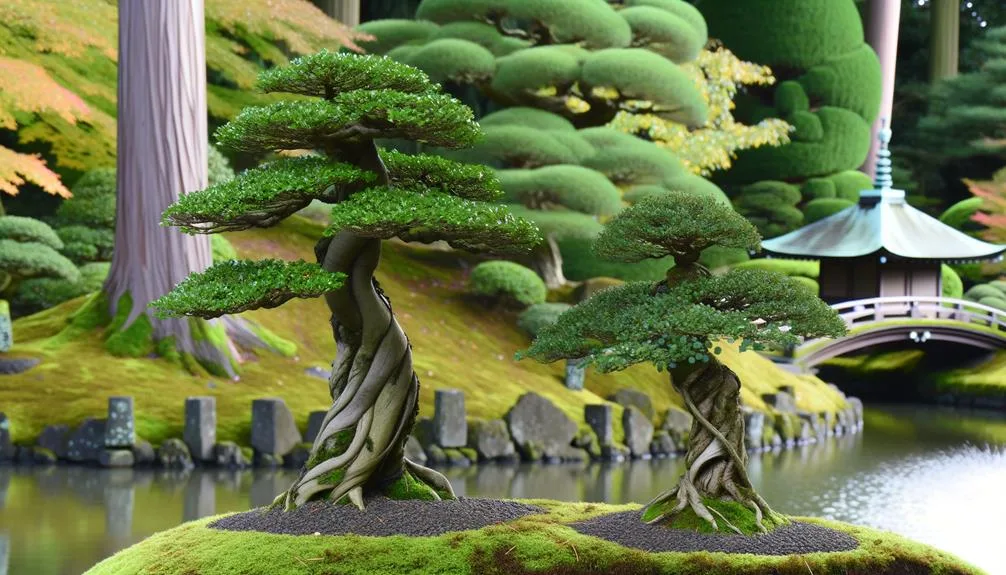
While mastering the Yose-ue style can transport you into a miniature forest landscape, studying the Sokan style introduces you to a distinctive bonsai display that captures a harmonious balance between two separate entities. This differs from other multi-trunk bonsai styles, such as Ikadabuki, Sokan, or the twin trunk bonsai style, features two trunks growing from a single root system. The trees are rooted together, yet each trunk emerges independently, symbolizing harmony and resilience.
Key elements in Sokan style include:
- The taller trunk, known as the parent, grows upright. The shorter, or child trunk, often leans. This dynamic adds a compelling contrast to the composition.
- The trunk’s initial branch typically appears on the same side as the child trunk, following certain accepted styles.
- The trunks represent a parent-and-child relationship, signifying the passage of time.
To appreciate Sokan style, it requires one to recognize the balance between shared rootedness and individual growth. This style isn’t solely about how the trunks grow; it’s about the tale they narrate. When you immerse yourself in this style, you’re not just crafting bonsai, you’re creating a narrative of harmony, resilience, and time.
Techniques for Shaping Multi-Trunk Bonsais
To shape your multi-trunk bonsai effectively, mastering a variety of techniques is crucial. These include directional pruning, wiring, selective branch pruning, and thread grafting. Utilizing these techniques can assist in creating styles such as ikadabuki, where the tree’s form and direction are paramount.
Directional pruning fosters balanced growth among the various trunks. You can direct the growth by making strategic cuts that encourage the tree to grow in a specific direction.
Another method, wiring, involves using wires to guide the position of each trunk, allowing you to manipulate the bonsai tree to conform to a specific style.
Selective branch pruning is key to maintaining overall harmony and proportion. It involves removing branches that disrupt the balance of the bonsai.
Thread grafting can be beneficial as well, serving to connect individual trunks and create a cohesive visual flow.
A salient feature of multi-trunk bonsai styles is strong surface roots. These roots lend stability and provide visual support for the multiple trunks. Regular evaluation and adjustment of the positioning and angle of each trunk is necessary to achieve a natural and harmonious composition.
The form of your bonsai will develop as you become more proficient in these techniques.
Symbolism and History of Multi-Trunk Bonsai
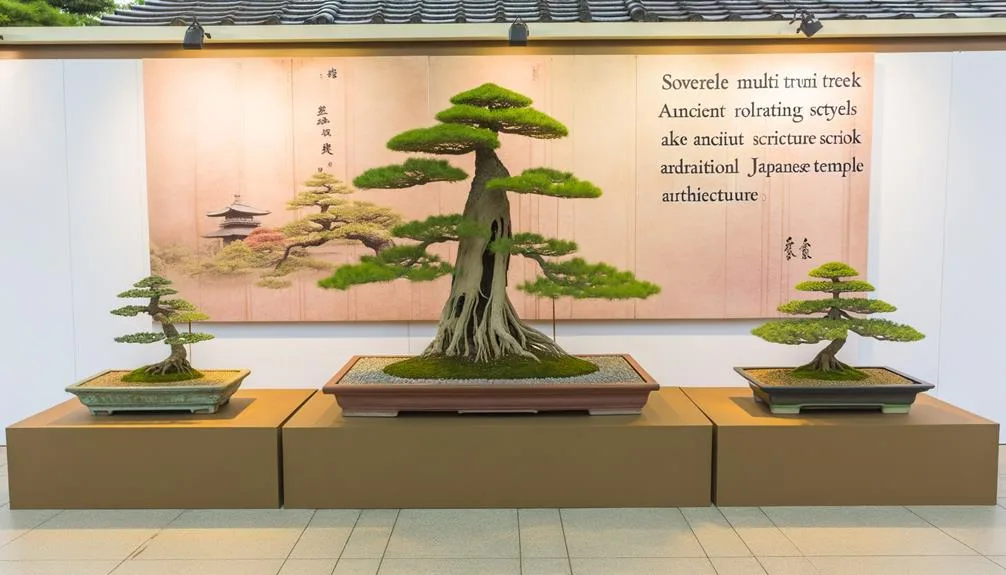
Diving into the past and meaning of multi-trunk bonsai exposes a rich cultural importance and creative interpretation. This type of bonsai, which involves styles such as Ikadabuki, denotes unity and family, imitating a cluster of trees evolving together from a solitary set of roots.
The multi-trunk bonsai styles represent the following:
- Ikadabuki: This style encapsulates the spirit of a forest environment, with a lone tree being the main focus. The smaller trunk and branches with sufficient spacing give the impression of depth, forming a mini forest.
- Formal Upright Style: In this style, a vertical trunk symbolizes power and resilience. This style often includes a larger main trunk with smaller ones around it.
- Cascade Style: This style imitates the organic growth of trees on sharp cliffs. The trunk cascades downwards, symbolizing adaptability and survival against challenges.
The meaning and history of multi-trunk bonsai echo the harmony between humans and nature. The style is a tribute to the beauty of nature and the artist’s skill in reproducing it on a smaller scale. Mastering this art form necessitates comprehension of these profound meanings.
Frequently Asked Questions
What Is the Rule of 3 in Bonsai Tree?
In bonsai aesthetics, the Rule of 3 guides your pruning techniques, foliage balancing, and trunk shaping. It’s about positioning three main branches at varied heights for balance. It’s a fundamental part of bonsai history.
What Is the Double Trunk Bonsai Rule?
In double trunk bonsai, you’re balancing two trunks from a single root, valuing aesthetics and symbolism. Trunk thickness, branch arrangement, and root distribution matter. It’s challenging, requiring pruning and care, but rewarding as your bonsai ages.
What Is the Most Sought After Bonsai Tree?
The most sought after bonsai tree is typically the Japanese White Pine. Its long lifespan, stunning aesthetics, and adaptability to indoor or outdoor conditions make it a favorite. However, it does require careful maintenance.
What Is the Rarest Type of Bonsai?
You’re seeking the rarest bonsai type. It’s the Ikadabuki, or Raft style. Mastering its creation involves bonsai maintenance, root pruning, leaf trimming, and careful soil selection. It’s a challenging yet rewarding bonsai training journey.
